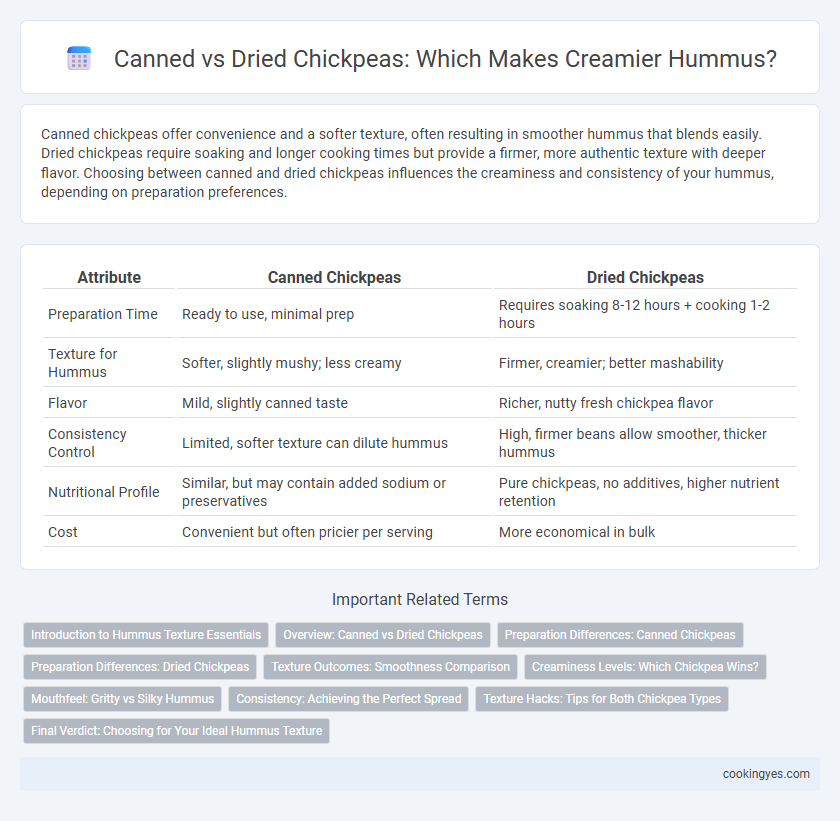Canned chickpeas offer convenience and a softer texture, often resulting in smoother hummus that blends easily. Dried chickpeas require soaking and longer cooking times but provide a firmer, more authentic texture with deeper flavor. Choosing between canned and dried chickpeas influences the creaminess and consistency of your hummus, depending on preparation preferences.
Table of Comparison
| Attribute | Canned Chickpeas | Dried Chickpeas |
|---|---|---|
| Preparation Time | Ready to use, minimal prep | Requires soaking 8-12 hours + cooking 1-2 hours |
| Texture for Hummus | Softer, slightly mushy; less creamy | Firmer, creamier; better mashability |
| Flavor | Mild, slightly canned taste | Richer, nutty fresh chickpea flavor |
| Consistency Control | Limited, softer texture can dilute hummus | High, firmer beans allow smoother, thicker hummus |
| Nutritional Profile | Similar, but may contain added sodium or preservatives | Pure chickpeas, no additives, higher nutrient retention |
| Cost | Convenient but often pricier per serving | More economical in bulk |
Introduction to Hummus Texture Essentials
Hummus texture hinges on the choice between canned chickpeas and dried chickpeas, where canned chickpeas offer convenience with a softer, creamier consistency due to pre-cooking. Dried chickpeas, when soaked and cooked properly, yield a firmer, more textured hummus, allowing greater control over moisture and blending. Understanding these textural differences is essential for achieving the desired smoothness and mouthfeel in authentic hummus recipes.
Overview: Canned vs Dried Chickpeas
Canned chickpeas offer convenience and a softer texture, making them ideal for quick hummus preparation with a smoother consistency. Dried chickpeas require soaking and longer cooking times but provide firmer, creamier results that enhance hummus texture and flavor depth. Choosing between canned and dried chickpeas depends on the desired balance between ease of use and optimal hummus consistency.
Preparation Differences: Canned Chickpeas
Canned chickpeas offer a convenient, time-saving option for hummus preparation, as they require no soaking or extended cooking. Their softer texture allows for quicker blending into a creamy consistency, though they may sometimes result in a slightly less dense hummus compared to dried chickpeas. Using canned chickpeas reduces meal prep time significantly while maintaining a smooth, palatable texture ideal for homemade hummus.
Preparation Differences: Dried Chickpeas
Dried chickpeas require soaking for 8-12 hours followed by simmering for 1-2 hours to achieve a tender texture ideal for creamy hummus. This longer preparation develops a richer, nuttier flavor and smoother consistency compared to canned chickpeas. Properly cooked dried chickpeas offer superior control over hummus texture, enhancing overall quality.
Texture Outcomes: Smoothness Comparison
Canned chickpeas produce a creamier and smoother hummus texture due to their pre-cooked softness and higher moisture content. Dried chickpeas, when properly soaked and cooked, offer a denser texture that can result in a slightly grainier hummus if not blended thoroughly. The choice between canned and dried chickpeas directly impacts the hummus's mouthfeel, with canned chickpeas favored for ultra-smooth consistency and dried chickpeas yielding a more rustic, textured finish.
Creaminess Levels: Which Chickpea Wins?
Canned chickpeas offer a softer, creamier texture ideal for smooth hummus, thanks to their pre-cooked moisture content, while dried chickpeas require soaking and cooking, allowing more control over firmness but often resulting in a slightly grainier texture. The pre-soaked nature of canned chickpeas enhances emulsification with tahini and oil, producing a velvet-like consistency preferred in traditional recipes. For maximum creaminess, many chefs recommend canned chickpeas, though properly cooked dried ones can achieve similar richness with careful technique.
Mouthfeel: Gritty vs Silky Hummus
Canned chickpeas tend to produce hummus with a slightly gritty texture due to their softer, often overcooked outer skins, affecting the overall mouthfeel. In contrast, dried chickpeas, when properly soaked and cooked, yield a smoother, silkier hummus with a creamier consistency that enhances the sensory experience. The choice between canned and dried directly impacts hummus quality, with dried chickpeas favored by chefs seeking a refined, velvety texture.
Consistency: Achieving the Perfect Spread
Canned chickpeas offer a softer texture that blends smoothly, resulting in a creamy and consistent hummus spread with minimal preparation time. Dried chickpeas, when properly soaked and cooked, provide a firmer bite enhancing the hummus' body and richness, allowing for greater control over texture. The choice impacts the spreadability and mouthfeel, with canned chickpeas favoring convenience and dried chickpeas delivering a more customizable and robust consistency.
Texture Hacks: Tips for Both Chickpea Types
Canned chickpeas provide a softer, creamier texture ideal for smooth hummus, while dried chickpeas offer a firmer, nuttier bite after proper soaking and cooking. To enhance texture, mash canned chickpeas thoroughly or blend with a touch of aquafaba, and soak dried chickpeas overnight with baking soda to soften before cooking. For a silky hummus, peel the skins off chickpeas regardless of type, and add ice-cold water while blending to achieve optimal creaminess.
Final Verdict: Choosing for Your Ideal Hummus Texture
Canned chickpeas offer convenience and a softer texture that blends smoothly, creating a creamy hummus ideal for quick preparation. Dried chickpeas, when soaked and cooked properly, provide a firmer, earthier bite that enhances hummus complexity and allows greater control over texture. Selecting canned or dried chickpeas depends on balancing time efficiency with desired creaminess and flavor depth in your final hummus.
Canned Chickpeas vs Dried Chickpeas for Hummus Texture Infographic

 cookingyes.com
cookingyes.com